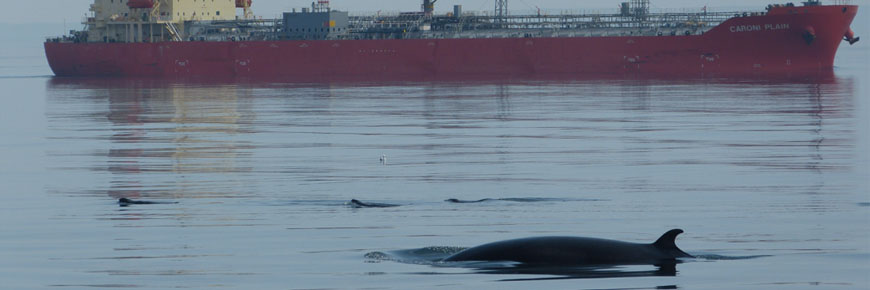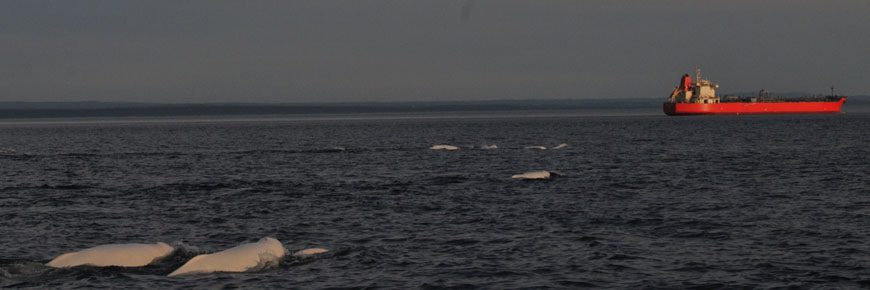
A minke whale (with grey seals behind) in the St. Lawrence Estuary
Managing ships and whales in the St. Lawrence Estuary
Saguenay-St. Lawrence Marine Park, Quebec
Streaming along in the St. Lawrence Estuary, a container ship almost 300 meters long carries goods to the big markets upstream. But it’s not the only giant navigating these waters.
Barely half a kilometre away, an endangered blue whale thirty meters long makes a dive, its back curving gracefully, its small triangular dorsal fin sliding under the waves. It leaves behind a patch of water as smooth as silk—a whale “footprint.”
This snapshot of two giants captures one of the biggest challenges for Saguenay-St. Lawrence Marine Park. Both ships and whales use these waters. How do experts keep the two from colliding?
The marine park—one of Canada’s first marine protected areas—is located at the confluence of the Saguenay Fjord and the St. Lawrence Estuary. It is an important feeding ground for the whales, and for belugas it is also a calving area.
But the estuary is also a major shipping route, linking the ports of the Great Lakes to the rest of the world. Commercial ships make an average of 7 500 trips per year through this area.
And then there’s the boat traffic from tourism. Estimates put the number of commercial whale-watching trips at 13 000 and recreational boat trips at 9 000.
There are now regulations in place for the whale-watching and pleasure boats governing their behavior around whales. But ships have been a major problem for the whales—minkes, belugas, blues, humpbacks and fin whales. (Blue and beluga whales are endangered, and fin whales are of special concern.)
Did you know?
Since 1992, Parks Canada has documented over 45 incidents of vessel-whale collisions (which includes whales exhibiting collision-type injuries) in the marine park and surrounding waters. This number covers collisions involving all kinds of vessels, from pleasure boats to commercial ships. Since many collisions may go undetected or unreported, scientists believe the number is actually higher. For an endangered species such as the blue whale, the loss or injury of even a few individuals can seriously affect the population. In fact, collisions are listed as a threat to the recovery of all marine mammal species at risk in the St. Lawrence.
A shared solution to a shared problem

In 2011, concerned experts formed the Working Group on Marine Mammal Protection and Shipping. This group brought together representatives from whale research groups, the shipping industry, economic development groups, academia and the federal government.
As co-chair of the working group, Parks Canada used its Geographic Information Systems (GIS) to analyze data on whale distribution and habitat. The agency then worked with the shipping industry to construct scenarios and propose measures to reduce the risk to whales.
The group came up with voluntary measures for the shipping industry. Ships would reduce their speed in whale feeding grounds and avoid altogether an important blue whale area. They would also maintain a route to avoid a sensitive area frequently used by beluga herds composed of females and young.
Maneuvering space for the whales
Overall, ship pilots complied with the voluntary measures. Between 2013 and 2016, Parks Canada found that on average, ships reduced their speed by 2.8 knots (just over 5 kilometers per hour). The reduction meant that the average speed of vessels through the whale feeding grounds was very close to the recommended 10 knots (18.5 kilometers per hour).
Speed reduction resulted in a nearly 40% decrease in the risk of collisions.
“At a certain speed,” says Nadia Ménard, ecosystem scientist at the park, “whales are able to avoid the ships. And if a collision does occur at a slower speed, it’s less likely to be fatal.”
The measures are presently provisional, Ms. Ménard adds. “The aim is to use the best available science to refine the areas and revisit the voluntary measures.” says Ms. Ménard.
Next task for the working group: to study how ship noise affects whales…and to take measures to reduce its impacts.
- Date modified :